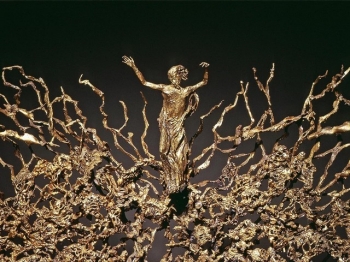Easter message from the Grand Master
 Pericle Fazzini, Study for the “Resurrection”, 1969-1970, Vatican Museums.
Pericle Fazzini, Study for the “Resurrection”, 1969-1970, Vatican Museums.
Easter is a ‘story’ that is passed on and an ‘event’ that continues. It is not a simple recurrence of the religious calendar, even if it is sometimes perceived that way; nor is it merely an annual event. Yet there is always an element of this, in respect to the repetitiveness of our lives, to the cyclic nature of the calendar and in the habits of not forgetting.
In the daily liturgy of the Mass, the Church prays to God: “as we celebrate the memorial of the death and resurrection of your Son… we give you thanks (o Father)” (Eucharistic prayer). We find the core of our Easter in these words; that is, we celebrate the death and resurrection of Jesus, thanking the Father for the love manifested to us in Him, our brother. In a famous homely on the Pasch, Bishop Melito of Sardis prefigured Jesus like a lamb: slain in Abel; bound hand and foot in Isaac; in Jacob a stranger; in Joseph sold; in Moses exposed on the waters; in David persecuted; in the prophets dishonoured; sacrificed at eventide, buried at night and not subjected to corruption, because God raised him from the dead by drawing him from the depths of the tomb and reviving humanity in him. God’s inscrutable plan becomes a ‘sign’ or ‘sacrament’ of salvation. Easter is a sacrament of grace!
Jerusalem, with the empty tomb, is the place of the event, but the tremor of his resurrection went beyond the holy City and beyond all time.
The Eternal Lord spoke to him
The book of Exodus tells us that Moses, moved by the theophany, or powerful manifestation of the Eternal Lord speaking to him, sought a hiding place on Sinai, such was his surprise and his fear: “I will put you in a cleft of the rock, and I will cover you with my hand” (Ex 33:22) the Lord then said to him. Moreover, Moses saw a little of the glory of God. That “cleft of rock” was the prefiguration of Jesus’ tomb carved in the rock, and in the words - ‘I will cover you with my hand’ - there was a pious gesture of affection, almost a final caress of the Father towards the sacrificed Son of man and Son of God. The primordial womb of Mary was now replaced by the womb of the cold earth.
However, it could not all end in such a way. “Then I will remove my hand” the Eternal Lord had said to Moses, and it was new life. Jesus is risen! The resurrection is the life that Jesus takes up again; he is not a revenant, dead only by appearance; his life is no longer what it was before. In Him, there is new life and with it, he precedes his disciples and us in that ‘Galilee’ of the peoples where our existence, our work, our illnesses and fears, our sins humble us.
The gift of the Risen Lord is a gift that we need
The Church now proclaims in the same words of the Angel: “Do not be afraid (…). Come, see the place where he lay (…) Behold, he is going before you to Galilee; there you will see him. (…) Lo, I have told you” (Matthew 28:5-7)
This encounter with the Risen Lord has an index of absolute necessity; it is necessary in order to re-establish relations with the confused disciples, new relations that stir the spirits: “Peace be with you” (John 20:19). Peace is the gift of the Risen Lord, and God knows how much we need it in order to reconcile ourselves with nature, with ourselves and with others, and to give meaning to the faith that is troubled by unbelief, in order to centre ourselves on Christ.
Today, a new Easter
We live in a new Pasch of resurrection still shrouded by the fog of the Covid-19 pandemic (and we do not know how long it will last), with its Lenten restrictions and perhaps purification, but also laden with many hopes. The papal trip to Iraq, the land of many martyrs, which was so brief but intense, has raised expectations there of peace and reconciliation, as well as the possibilities of dialogue and understanding between peoples and religions that have always been in conflict for supremacy, thus opening a horizon that embraces the whole of the Middle East, Palestine, Syria and every continent.
The visit to Ur of the Chaldeans had – I would say – a profound universal flavour: Ur was the homeland of Abraham, the man who believed, and to whom Jesus made a clear Easter reference: “Abraham rejoiced that he was to see my day; he saw it and was glad” (John 8:56). Abraham had glimpsed the day of Jesus and at the same time the day of his resurrection, rejoicing in his heart, because the promises of becoming father to a multitude of peoples were fulfilled in this ‘other’ Son (cf Gen 17: 5-8).
At Easter, we can now look up to the Risen Lord, who was pierced and whose wounds have been made glorious. We must not forget. Jesus fulfils the promises of the covenant with Abraham and his resurrection renders them eternal. The Risen Lord therefore, has meaning for our life and our humanity.
As Knights and Dames of the Holy Sepulchre, we know that we can make our contribution to peace and to the good; we are custodians and missionaries of the Easter proclamation: Peace, peace be with you, the Lord is truly risen!
Happy Easter!
Cardinal Fernando Filoni
(March 29, 2021)



